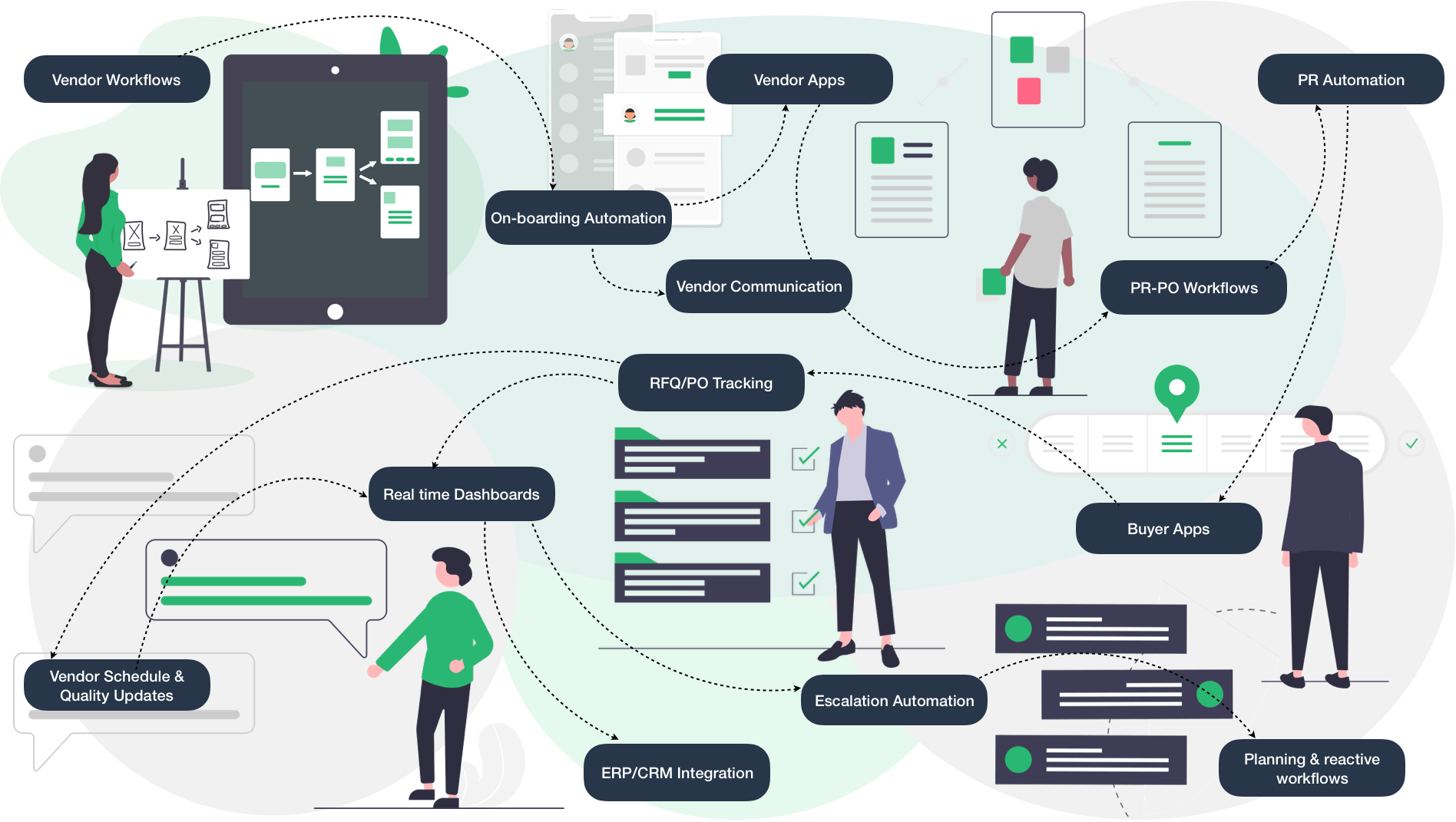Procurement and supply chain automation processes are often very complex and unique to different organizations. Workflows typically span multiple functions and data systems, time-bound synchronization of activities is critical, approvals and data-driven decision points abound, and yet these processes are notorious for being paper-based, email-driven and extremely unstructured. Organizations often refer to these collection of workflows as procure-to-pay or source-to-pay or request-to-order or order-fulfilment processes.
Benefits of procurement and supply chain automation
Automating part or all of these procurement and supply chain automation processes has a number of potential benefits for businesses:
- Reduce manual effort while increasing productivity, efficiency, and accuracy.
- Increase visibility across the entire cycle and, in turn, manage cash flows and inventory levels better
- Assist in data driven planning and strategy decisions.
- Improve supplier relationships and build deeper strategic relationships
No wonder, these processes are at the fore front of any organization’s wish list for automation.
Current landscape of supply chain management and procurement automation solutions:
Across enterprises, these processes are quite similar at first glance – users place requests, buyers finalize vendors and issue POs, vendors deliver and get paid, supply chain professionals track and ensure timely deliveries. Users could be merchandizers placing orders for stacking up their store shelves, plant heads placing requests for replacing or augmenting a manufacturing line-up, manufacturers placing orders for raw materials, projects teams placing requests for capital goods and furniture to build out a new store or outlet, or individual employees or teams placing orders for laptops, mobiles or other similar goods. Requests could be budgeted or incidental, part of CAPEX or OPEX, paid for under different profit and loss centers, and prioritized and categorized many different ways. Supply chains can span geographies and tax regimes, and a variety of transport mediums.
There are often many different tools for supply chain management and procurement automation at play here:
- Specialized procurement software to run RFP/RFQ or e-auction processes
- Vendor management tools for on-boarding, reviewing and collaborating with vendors, suppliers and partners
- Contract management tools to track and enforce compliance
- Control towers to monitor and track supply chains
- Accounts payable and reconciliation tools
- Financial ERP systems to issue and track POs and payments
- Warehousing and inventory management tools
- HR management systems to track employees and approval hierarchies
- Product information systems
Procurement and supply chain Automation challenges:
The last mile in the journey towards the digital transformation of such processes is often the most challenging. Most organizations struggle with the limitations enforced by off-shelf solutions or the frequent changes in processes that make custom-developed tools obsolete faster than they can add value.
1. Data is not unified, processes are manually orchestrated
Organizations may be at different points in their automation journeys and in-spite of investment in several of the above-mentioned tools, many gaps may still exist. Many of these tools work in silos, do not interface or orchestrate processes across other tools, and are built on different types of technology platforms. As a result, daily workarounds that defy automation goals abound and slowly but steadily you keep sliding down a slippery slope replete with unused SaaS licenses, data silos and excel files galore. Decisions get made with incomplete or outdated data. This slows down the planning processes and hampers strategic direction changes.
2. Tools are not customized to unique business needs
Every business has its own specialized nuances for driving a lot of this process. No two businesses have the same rules around approval processes and delegation of authorities. Classifications of procurement items is often unique, with unique criteria for the selection of vendors. CAPEX and OPEX budgeting is handled differently, and so are payment and delivery terms and enforcement thereof.
Several of these off-shelf tools provide rich, powerful functionality for specialized workflows. However, they are expensive to procure, and as a general rule, they’re difficult to customize. In all likelihood, you’ll have to adapt how you do business to fit the way the software functions. And this often becomes the primary reason why adoption falters and change management become extremely challenging.
3. Un-structured solutions to fill in gaps, and dependency on people
More often than not, procurement and supply chain management teams deal with lots of excel files to track statuses, change requests, delegation of authorities, all sorts of approvals and rejections and vendor feedback. Its complemented with business domain knowledge that resides with key people in the team to shortlist the right vendors, route the approvals to appropriate functions, collate requests and negotiate. These individuals with innate domain expertise not captured in any formal tool often become your organization’s bottle necks and single points of failure. Decisions and prioritization often get done based on personal preferences and influence rather than enforceable rules.
At the end of the day, these challenges result in delays that have significant financial impacts, adversely affect your operational efficiency due to poor utilization of resources, and hamper agility and speed of change due to poor data visibility.
Opportunities for automating your procurement and supply chain processes
The true impact of automation can only be delivered if all the disjointed workflows are tied together with real-time exchange of information, unified data sources, seamless orchestration of activities, and replacement of manual, repetitive and error prone work with automation bots where possible.
1.Vendor and supplier management
Simplify your business processes and easily create stronger relationships with your vendors by collaborating with them in a secure, online environment. This includes easy to use and contextual mobile apps and web portals for common workflows like:
- Vendor and supplier on-boarding requests and vendor/supplier master data collection with built in validations and instant communications to speed up processes
- Automated data analysis based on factors such as current market trends, historic spend, and overall organizational goals for business development, to identify and evaluate potential vendors and suppliers for any given purchase request.
- Interfaces for vendors to interact with the buyer and their procurement software and workflows. Review and respond to RFx, acknowledge POs etc
- Interfaces to mage updates to master data, self-service requests for dispute resolutions and other administrative and payment issues
- Vendor rating and feedback management
Vendor updates on deliveries, schedules, external reviews and critical milestones in the supply process.
2. Purchase requests to RFx and bidding processes
Replace manual user requests over emails and phone calls, to streamlined forms that users fill out to make their requests, with intelligent automation behind the scenes that
- Filters out the requests into different categories
- Collates requests from multiple users into common purchasing threads
- Compares data across systems to classify requests as conforming to annual budgeted plans or not
- Evaluate requests against customized business rules for approvals, and route the requests accordingly
- Shortlist vendors from databases based on business rules, vendor ratings, vendor categories, past purchase decisions for similar items
- Evaluate requests against any existing annual contracts with chosen vendors, and if appropriate, issue PO directly post requisite approvals
- All relevant “RFx” documentation, such as requests for quote (RFQ), requests for proposal (RFP), request for information (RFI), etc. is prepared, reviewed, and approved for distribution.
- Auto-generate RFPs and send communications to shortlisted suppliers and vendors
- Keep the requestor updated on the status of the request at each step of the way
3. Requisition to Purchase Order processes
Add structure and automation to vendor interactions as part of vendor shortlisting and selection, order approvals and exception management.
- Detailed instructions and reference materials for vendors to study RFPs and RPFQs before responding
- Standardized templates for responses with built in sanity checkers and data validations to weed out incorrect or inadequate responses
- Time bound communications with automated follow-ups
- Automated quote comparison sheets for buyers to review
- Automated allocations of purchases to vendors based on rules, with manual over-rides and approvals where relevant
- Vendor and PO information confirmation with automated messaging and approvals
- Initiation of PO processes in the ERP tools with automated information exchange
- Automating the generation of legal and commercial contracts
4. Purchase Orders to Delivery processes
Enforcement and tracking of PO delivery terms, and quality and external approvals for high value or custom manufactured items.
- Vendor PO acceptance and agreement on production and delivery milestones
- Real-time updates from vendors on relevant milestones via mobile apps
- Escalations and reactive workflows for anticipated delays and/or changes to terms or product features/quality
- Track any required safety/quality approvals required and violations to be handled with reactive workflows
- Real-time visibility into batch-wise deliveries and up-coming schedules to plan downstream activities accordingly
- Contract management for longer-term supply agreements
- Goods Receipt & Payment tracking – orders are reviewed and, ideally, receiving paperwork is automatically cross-matched to the corresponding PO. Any exceptions generate returns, refunds, or additional documentation as required by circumstances.
- Accounts payable (AP) processes
5. Vendor/Supplier collaboration with real time updates
For time-critical, or high value or manufactured goods, visibility into vendor processes gives buyers and stake-holders down the line data to plan subsequent operations.
- Alignment on schedules for various milestones and final delivery
- Reactive workflows for delays and critical escalations
- Tracking of third party inspections and other necessary quality compliances
- Batch delivery constraints and alignments
- Exception management for production shortages, transport issues, documentation mismatches etc
Intelligent automation platforms for procurement and supply chain automation
With the advent of no-code platforms and intelligent automation capabilities, supply chain management and procurement automation professionals now have a whole new set of options to tackle the toughest automation challenges. Relative to a medley of off-shelf tools or developer driven customized solutions, no-code platforms like Zvolv offer several differentiators:
CUSTOMIZATION FLEXIBILITY:
You don’t need to hire expensive developers with specialised skills to deploy processes for you. And you don’t have to compromise on feature depth or customisation flexibility either. Zvolv Process Automation requires no coding to build a majority of your application, using simple business logic to create your tasks, forms and workflows by those who best understand the business needs. And complement with intelligent automation that encapsulates complex business logic – your proprietary algorithms, analytics, decision-support data-crunching, integration with your other IT and data systems or ML models.
SPEED OF EXECUTION
No-code applications are more often than not ready in days! Get your Minimal Viable Product up and running in hours, test it out with your teams and iterate until users are confident and have accepted the functionality. Then work on augmenting your MVP with intelligent automation bots to off-load any repetitive or data-intensive or error-prone activities. Zvolv offer unrivalled time to value when it comes to complex automation, customized to exact needs.
TOTAL COST OF OWNERSHIP
Unlike other platforms, Zvolv apps don’t penalise you for being more successful. True transformation only happens when you have extensive usage across your organisations, not just by a few middle managers that you buy licenses for. With Zvolv, there are no per-user licenses nor any limits imposed on how much or how often you use your applications. With a simple building block based licensing model, you pay predictable license fees year-on-year once you have built and deployed your applications.
USER ADOPTION
Unlike off-shelf tools, Zvolv apps don’t force your users to change the way they run their processes. Zvolv apps adapt to your needs, and can foster change at the pace your organisation is comfortable with. With a modular building block based approach, most organisations building applications on Zvolv start with automating and adding structure to the most pressing pain points, and then augment with additional processes and automation bots over time. With extensive integrations with other tools, Zvolv applications can start by filling gaps in your data, and then integrate more functionality over time
EXTERNAL ACCESS
Empower your business to enable external users such as vendors, suppliers, partners to provide real-time status updates, feed in data, or access need-to-know information from your Zvolv apps. You can control who can join, enforce contextual access to information and functionality for individual business processes. With white-labeled mobile applications, public/private forms, expiring and authenticated sharing links, geo or time or device locked access restrictions – Zvolv provides a whole range of features to make your applications integrated beyond your organisational boundaries. And not to mention, no per-user license fees. So go ahead, think as broad as you can.



